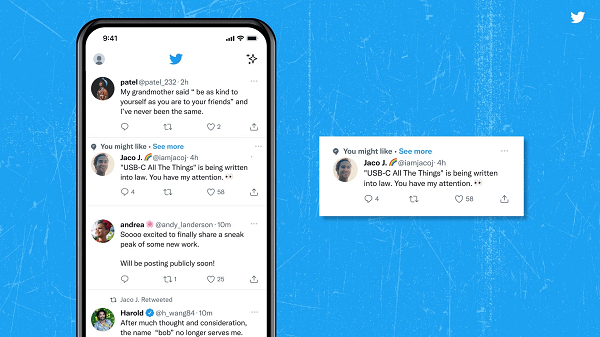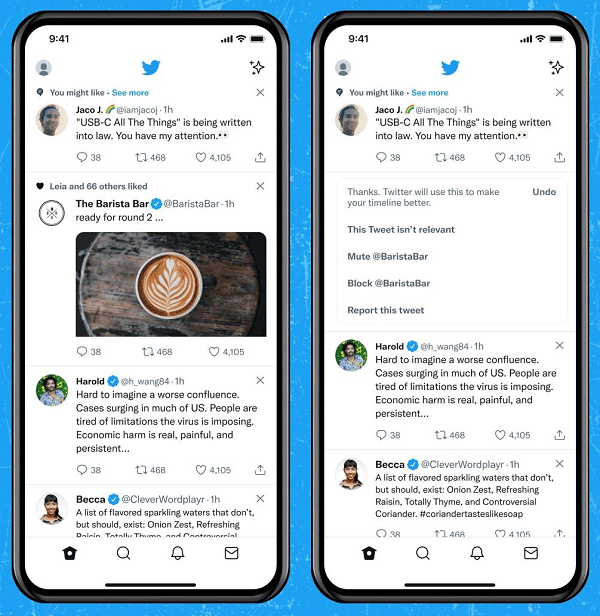As is the current trend with all social platforms, Twitter is experimenting with new ways to recommend content in user feeds, in order to show you more of what you might like, and ideally, keep you active in the app for longer.
Which, as we’ve seen with Meta’s efforts, has seen varying levels of success. But with TikTok fueling a whole new content shift, by focusing on AI-based recommendations, as opposed to your social graph, every platform now sees opportunity to incorporate the same, highlighting the best posts that they have to offer to increase time spent.
And Twitter is no exception. Today, Twitter has provided a new overview of how it adds recommended tweets into user feeds, while it’s also launched a new experiment to give users more control over such.
As explained by Twitter:
“If you’ve ever seen a Tweet you enjoyed from someone you didn’t follow, you’ve probably seen a recommendation. Think of them as personalized suggestions that are shown to you based on actions you take on Twitter.”
Twitter says that its recommendations – which can be shown on your Home timeline, the Notifications tab, Topic Landing Pages, Explore, the Spaces Tab and more – are displayed based on your various in-app actions.
“The content we recommend to you is informed by actions you take on Twitter, also known as signals. Signals can include things like interests you’ve told us about, Topics you follow, Tweets you engage with, and even Tweets people in your network like. Based on these signals and more, we’ll show you content we think you’ll be interested in.”

Recommended tweets are not as prominent as the current wave of AI recommendations on Facebook and Instagram, though Twitter did get ahead of the game on this, at least in some respects, by ramping up its tweet recommendations back in 2017. Which people hated, which then forced Twitter to scale back, and since then, it’s been hesitant to go too hard on pushing more tweets from people you don’t follow into your feed.
Which, really, is because Twitter’s recommendation algorithms just aren’t that great. Some of the recommendations are interesting, and can enhance the tweet experience. But often, as with Twitter’s ‘What’s Happening’ trends, they’re only vaguely relevant, sometimes highly offensive, or untargeted, not personalized, etc. A lot of the time, Twitter just seems to be chucking stuff at you in the hopes that you’ll catch some it, but it doesn’t seem like there’s a heap of focus there.
This also extends to Spaces, with the Spaces tab generally being a mess of whatever discussions are happening at any given time, with little personalization or relevance. Twitter’s trying to improve this with Stations and topic-related elements, so that you can manually indicate your interest in specific subjects, while Spaces hosts are also being asked to enter topics for their chat.
But really, like TikTok, Twitter shouldn’t have to ask for your explicit input, it should be able to infer greater relevance based on your in-app activity, which it’s never really mastered.
Which is why its recommended tweets tend to stick out more in stream.
But Twitter is still developing its processes, with its latest experiment being a new ‘X’ button on recommended Tweets, making it easier to remove them from your Home timeline and share your feedback.

Which is helpful, but again, TikTok’s allure in this sense is its capacity to ‘learn’ your viewing preferences in real-time, and show you more content based on what you’re engaging with, every single time you log in.
That, in effect, raises the bar for every other app, and the more they struggle to provide relevant, valuable recommendations, without manual input, the more they seem behind the times on this front.
Basically, it feels like Twitter should be doing better on this element, with its Explore page, in particular, still not personalized enough to maximize engagement.
Maybe, through these manual inputs, it can still improve, but again, it does feel like Twitter has fallen behind in this respect.
You can read more about how Twitter recommends content here.



